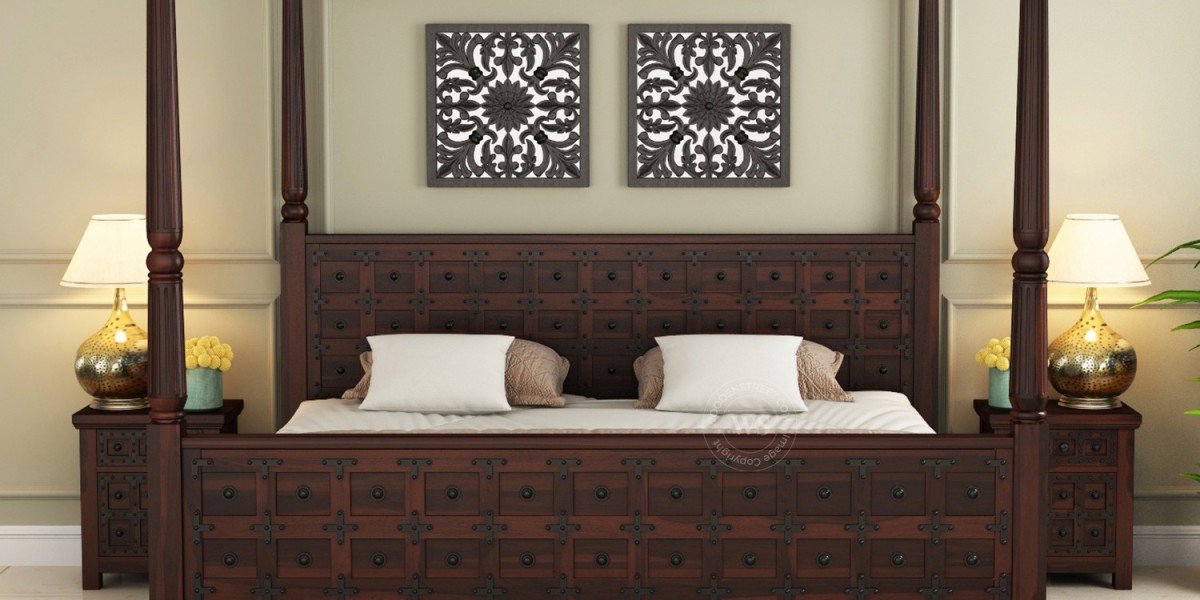When choosing the perfect double bed for your home, one of the most important decisions you’ll make is selecting the right material. The two most common options in the market are solid wood and engineered wood, each offering distinct advantages in terms of aesthetics, durability, cost, and functionality.
The material you choose not only determines the double bed’s lifespan but also its look, feel, and performance. So, how do you decide which one is right for your needs, preferences, and budget? In this article, we’ll break down the pros and cons of solid wood vs. engineered wood to help you make an informed choice.
What is a Solid Wood Double Bed?
A solid wood double bed is made from natural timber, typically cut directly from trees like teak, sheesham (Indian rosewood), mahogany, or oak. These beds are known for their strength, durability, and timeless beauty. Since no two pieces of wood are alike, each bed has a unique grain pattern that adds character and warmth to any bedroom.
Key Features:
Made entirely from natural wood
Heavier and more robust
Can be sanded and refinished multiple times
Long-lasting with proper care
What is an Engineered Wood Double Bed?
Engineered wood, also known as composite wood, is made by binding wood particles, fibers, or veneers together using adhesives. Popular forms include MDF (Medium-Density Fiberboard), HDF (High-Density Fiberboard), and plywood. These materials are often used in modern furniture for their affordability and versatility.
Key Features:
Manufactured wood composite
Lightweight and cost-effective
Smooth finish and consistent texture
Suitable for contemporary, minimalist designs
Comparing Solid Wood and Engineered Wood Double Beds
Let’s look at a detailed comparison based on key criteria to help you decide the best material for your double bed:
1. Durability and Strength
Solid Wood: Extremely durable and can last for decades. It can withstand wear and tear, making it ideal for everyday use. A solid wood double bed is a great investment for long-term use.
Engineered Wood: While high-quality engineered wood like HDF and plywood can be quite strong, it generally has a shorter lifespan compared to solid wood. It's more prone to damage from moisture and may sag over time under heavy weight.
✅ Winner: Solid wood
2. Aesthetic Appeal
Solid Wood: Offers a rich, natural appearance with unique grains and textures. Perfect for traditional, rustic, or luxurious interiors. A solid wood double bed adds timeless elegance to your space.
Engineered Wood: Comes with smooth surfaces and is available in a wide range of finishes, colors, and patterns. Ideal for contemporary or minimalist interiors.
✅ Winner: Tie (depends on style preference)
3. Cost and Affordability
Solid Wood: More expensive due to the cost of raw materials and craftsmanship. However, the long lifespan justifies the higher price.
Engineered Wood: Much more affordable, making it ideal for budget-conscious buyers or temporary setups. You can get a stylish double bed at a lower cost.
✅ Winner: Engineered wood
4. Weight and Portability
Solid Wood: Heavier and more difficult to move, especially during shifting or rearranging.
Engineered Wood: Lighter and easier to handle, making it suitable for apartments or rented accommodations.
✅ Winner: Engineered wood
5. Maintenance and Care
Solid Wood: Requires more maintenance — regular polishing, protection from moisture and pests. But it can be repaired and refinished easily.
Engineered Wood: Easier to clean and maintain in general, but once damaged, it’s harder to repair. Moisture can cause swelling or delamination.
✅ Winner: Solid wood (in the long term)
6. Environmental Impact
Solid Wood: If sourced sustainably, solid wood is eco-friendly and biodegradable. However, irresponsible logging practices can impact forests.
Engineered Wood: Uses fewer trees but involves adhesives and chemicals during manufacturing, which may not be as environmentally friendly.
✅ Winner: Solid wood (when sustainably sourced)
7. Customization and Variety
Solid Wood: Limited to natural tones and grains, but customization is possible through different wood types and finishes.
Engineered Wood: Available in a wide variety of styles, laminates, and finishes, offering more customization in terms of color and look.
✅ Winner: Engineered wood
When to Choose a Solid Wood Double Bed
Go for a solid wood double bed if:
You’re investing in a long-term, heirloom-quality piece
Your interior design leans toward classic, vintage, or rustic styles
Durability and natural beauty are your top priorities
You don’t mind the extra weight or higher maintenance
When to Choose an Engineered Wood Double Bed
An engineered wood double bed is ideal if:
You’re on a budget or furnishing a rental/home temporarily
You prefer lightweight furniture that’s easy to move
You like modern, clean designs with uniform finishes
You want a stylish solution without the cost of solid wood
Blended Solutions: The Best of Both Worlds
Some double bed designs offer a combination of both materials — for instance, a solid wood frame with engineered wood panels or drawers. This hybrid approach balances durability, aesthetics, and cost-effectiveness, making it a popular choice among modern homeowners.
Final Verdict: Which Material is Best for You?
The decision between solid wood and engineered wood ultimately comes down to your priorities.
If you value longevity, strength, and natural beauty, invest in a solid wood double bed. It’s a timeless choice that will serve you well for decades.
If you’re looking for a budget-friendly, stylish, and versatile solution, an engineered wood double bed might be the better option for your current needs.
Evaluate your room size, usage pattern, budget, and design preferences to make the best choice. After all, the right double bed is not just about sleeping — it’s about how it fits into your lifestyle and enhances your living space.






